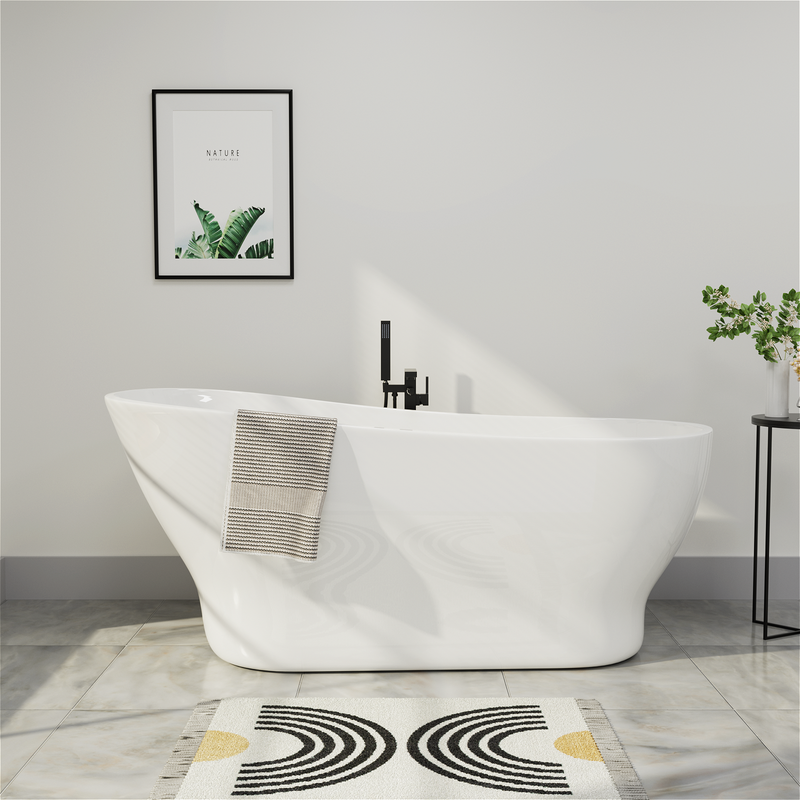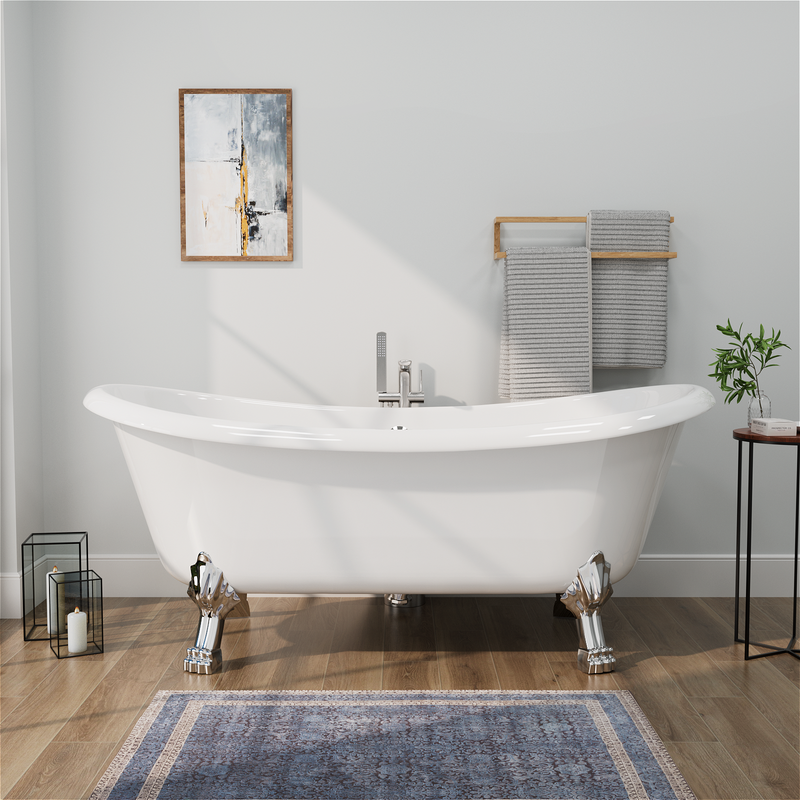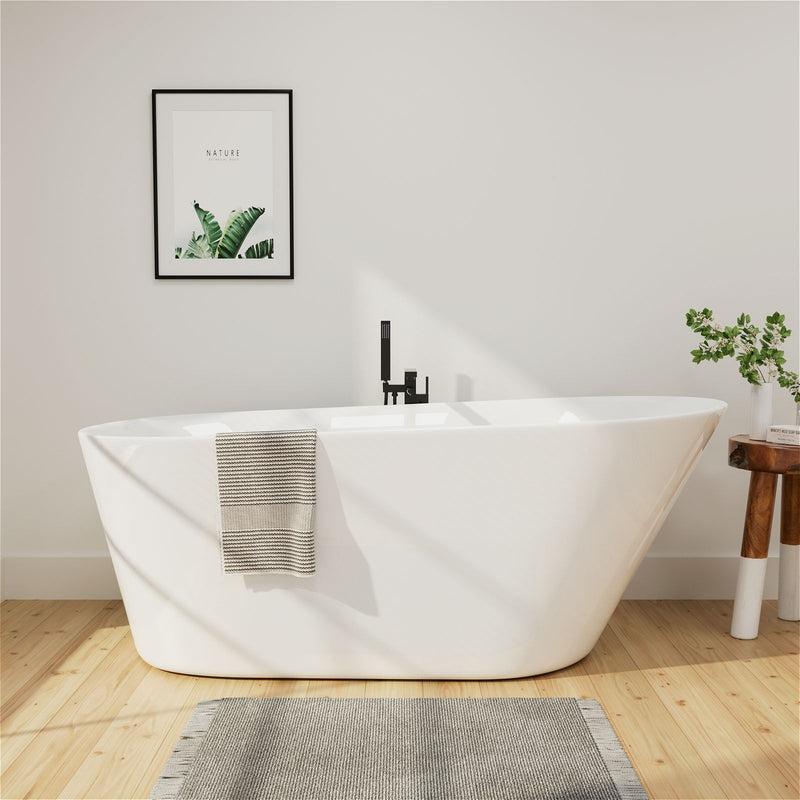A discolored bathtub can be frustrating, but that yellowing or staining doesn't mean permanent damage. Understanding what causes bathtub discoloration and how to address it can help restore your tub's original whiteness without expensive professional services. This guide provides proven methods to eliminate stains based on their specific causes, ensuring you can safely and effectively make your bathtub white again regardless of its material or age.
Understanding Why Bathtubs Lose Their Whiteness
Before attempting to restore your bathtub's whiteness, it's helpful to understand what causes discoloration in the first place. Different types of stains require different cleaning approaches, and proper identification can save you time and effort.
Water quality issues represent one of the primary causes of bathtub discoloration. Hard water, which contains high mineral content, leaves behind white chalky deposits known as limescale. These deposits accumulate over time, creating a dull, crusty appearance on your bathtub surface. In areas with significant iron content in the water, you might notice reddish or yellowish stains caused by iron oxidation. This occurs when iron particles in water are exposed to oxygen and begin to rust, similar to what happens to untreated metal outdoors.
Organic growth represents another common source of bathtub discoloration. Soap scum combines with body oils and minerals in water to create a sticky film that attracts dirt and bacteria. This filmy residue typically appears cloudy or grayish. Mold and mildew, which often present as black, pink, or greenish spots, thrive in the consistently moist environment of bathrooms. The pinkish film sometimes mistaken for mold is actually a type of bacteria called Serratia marcescens, which feeds on soap and shampoo residues.
Material-specific issues also contribute to bathtub yellowing. Porcelain enamel surfaces can develop microscopic cracks over time, allowing stains to penetrate beneath the surface. Fiberglass and acrylic tubs are susceptible to scratching, which creates rough areas that trap dirt and appear discolored. Older tubs may experience gradual fading or yellowing of the surface finish due to repeated cleaning with abrasive products or exposure to sunlight in bathrooms with windows.
Effective DIY Methods to Make your Bathtub White Again
You don't necessarily need expensive commercial products to restore your bathtub's whiteness. Several highly effective DIY methods use common household ingredients that are both economical and environmentally friendly.
The vinegar cleaning method works exceptionally well for mineral deposits and hard water stains due to its acidic nature. To use this method, fill a spray bottle with undiluted white vinegar and generously apply it to the stained areas of your tub. For best results, allow the vinegar to sit for at least 30 minutes—though for severe stains, you might leave it for several hours or even overnight. The acetic acid in vinegar gradually breaks down mineral deposits, making them easier to remove. After the waiting period, scrub the surface with a non-abrasive brush or sponge and rinse thoroughly with warm water.
Baking soda serves as a gentle abrasive that helps lift stains without damaging most tub surfaces. When combined with water to form a thick paste, baking soda can be applied directly to stained areas and left to sit for 15-30 minutes before scrubbing and rinsing. For enhanced cleaning power, create a combination paste using equal parts baking soda and vinegar—the chemical reaction between the two helps lift stubborn stains while deodorizing the surface. This method works particularly well on organic stains like soap scum and general grime.
Lemon juice offers a natural alternative to vinegar for dealing with hard water stains and mineral deposits. The citric acid in lemons effectively breaks down limescale while leaving behind a fresh scent. Simply cut a lemon in half and rub it directly on stained areas, or squeeze fresh lemon juice and allow it to sit before scrubbing. For tougher jobs, create a cleaning paste by mixing lemon juice with baking soda until it reaches a spreadable consistency. Apply this paste to stained areas, let it sit for at least 30 minutes, then scrub and rinse thoroughly.
For persistent organic stains like mold or mildew, a hydrogen peroxide solution can be highly effective. Mix equal parts hydrogen peroxide and water in a spray bottle, apply to the stained areas, and let it sit for 30-60 minutes before scrubbing and rinsing. Always test hydrogen peroxide on an inconspicuous area first, as it may have bleaching effects on colored surfaces.
Commercial Products for Stubborn Stains
When DIY methods prove insufficient for restoring your bathtub's whiteness, several types of commercial products can address more stubborn staining problems. Understanding which product works best for your specific stain type ensures better results while protecting your tub's surface.
Oxalic acid-based cleaners like those found in some commercial tub cleaners are particularly effective against rust stains and mineral deposits. These products work by chemically breaking down the metallic components of rust stains, making them easier to rinse away. When using oxalic acid cleaners, always follow package instructions carefully, wear protective gloves, and ensure adequate ventilation in your bathroom.
For mold and mildew removal, chlorine-based cleaners can be highly effective. These products not only remove existing stains but also help prevent regrowth by killing spores at the root. When dealing with black mold stains, apply the cleaner according to package directions, allowing sufficient contact time for the product to penetrate the growth. Never mix chlorine-based cleaners with other cleaning products, especially those containing ammonia, as this can create dangerous toxic gases.
Specialized tub cleaners designed specifically for bathroom surfaces often provide the safest option for maintaining your tub's finish while effectively removing stains. These products typically contain a balanced formulation that cleans effectively without damaging common tub materials like acrylic, fiberglass, or porcelain. Look for products labeled as appropriate for your specific tub material, and always follow the manufacturer's instructions for application and safety precautions.
When using any commercial cleaning product, proper ventilation remains crucial for your safety. Open windows or run bathroom exhaust fans during and after cleaning to ensure adequate air circulation. Always wear rubber gloves to protect your hands, and consider eye protection when working with splashing hazards.
Addressing Specific Types of Stains
Different stain types require targeted approaches for effective removal. Identifying the specific kind of stain affecting your bathtub allows you to choose the most appropriate cleaning method, saving time and effort while achieving better results.
Rust stains, which appear as orange or brownish discoloration, typically result from iron in your water supply or metal objects left in the tub. For fresh rust stains, lemon juice sprinkled with salt can be effective—the acid in the lemon combined with the mild abrasion from salt often lifts these stains without damaging the tub surface. For more stubborn rust deposits, commercial rust removers containing oxalic acid typically provide the most reliable results.
Pink slime, while often mistaken for mold, is actually a bacterial growth (Serratia marcescens) that feeds on soap and shampoo residues. This pinkish film typically responds well to vinegar solutions or hydrogen peroxide-based cleaners. Regular cleaning with either of these substances can help prevent recurrence, though addressing the underlying cause—soap film buildup—provides the most effective long-term solution.
Hard water stains appear as white, chalky deposits caused by mineral buildup from evaporated water. These stains respond well to acidic cleaners like vinegar, lemon juice, or commercial limescale removers. For persistent hard water stains, try saturating paper towels with undiluted vinegar and pressing them directly onto the stained areas, leaving them in place for several hours before scrubbing and rinsing.
Mold and mildew, which appear as black, green, or dark colored spots, require both surface cleaning and preventive measures. Commercial mold removers containing chlorine effectively eliminate existing growth, but addressing the moisture that enables mold is essential for preventing recurrence. Improve bathroom ventilation by running exhaust fans during and after showers, and consider using a squeegee to remove excess water from tub surfaces after each use.
Material-Specific Cleaning Considerations
Different bathtub materials require particular care to avoid damage while effectively restoring whiteness. Using the wrong cleaning approach can permanently damage your tub's finish, creating more problems than you started with.
Acrylic and fiberglass tubs require gentle cleaning methods to avoid scratching their relatively soft surfaces. Avoid abrasive scrubbing tools like steel wool or harsh scouring powders, which can create microscopic scratches that trap dirt and lead to more rapid discoloration. Instead, use soft cloths, sponges, or plastic-bristled brushes. Similarly, avoid strong acid-based cleaners unless specifically recommended by the manufacturer, as these can cloud or etch the surface. For these materials, baking soda pastes or mild liquid cleaners typically provide the safest yet effective cleaning options.
Porcelain enamel tubs, while more durable than acrylic, can still suffer damage from improper cleaning. The porcelain enamel surface can develop chips or cracks that expose the underlying iron material to moisture, leading to rust stains. Avoid using hard objects that could chip the surface, and promptly address any chips with appropriate repair kits. While porcelain enamel withstands more aggressive cleaning than acrylic, repeated use of abrasive cleaners can gradually wear down the glossy finish, making the tub more susceptible to staining.
Stone resin and composite tubs require specific care to maintain their appearance and integrity. These materials typically respond best to pH-neutral cleaners, as acidic substances can damage their protective sealant and surface finish. Always check manufacturer recommendations for cleaning products compatible with your specific tub material. For routine maintenance, mild soap and water often suffice, with periodic re-sealing as recommended by the manufacturer to maintain stain resistance.
Regardless of your tub's material, always test cleaning solutions in an inconspicuous area before applying them to the entire surface. This simple precaution can prevent costly damage and help you identify the most effective approach for your specific situation.
Preventive Measures to Maintain Whiteness
Regular maintenance proves far easier than dealing with established stains. Implementing simple preventive habits can significantly extend the time between deep cleanings while keeping your bathtub looking its best.
Immediate rinsing after each use represents one of the most effective preventive measures. Simply using a handheld showerhead or a cup of water to rinse away soap residue, shampoo, and body oils prevents them from combining with minerals in water to form difficult soap scum. This practice takes less than a minute but can dramatically reduce how frequently you need to perform deep cleaning.
Squeegeeing surfaces after use provides another simple yet highly effective maintenance technique. Using a rubber squeegee on tub walls and floors removes standing water that would otherwise evaporate and leave behind mineral deposits. When combined with proper bathroom ventilation, squeegeeing also helps surfaces dry more quickly, creating an environment less conducive to mold and mildew growth.
Regular deep cleaning on a consistent schedule prevents stains from becoming established and difficult to remove. For most households, a weekly light cleaning with mild products works well to maintain whiteness without excessive effort. The frequency of cleaning should reflect your household's usage patterns and water quality—homes with hard water or more users typically require more frequent attention.
Protective products can help maintain your tub's appearance between cleanings. Applying a specialized tub wax or sealant every few months creates a protective barrier that repels water and prevents staining agents from adhering to the surface. Always ensure the product you choose is compatible with your tub's specific material, and carefully follow application instructions for best results.
FAQs
What is the most effective natural method for cleaning a yellowed bathtub?
The combination of baking soda and vinegar typically provides the most effective natural cleaning for yellowed bathtubs. The chemical reaction between these two household staples helps lift stains without damaging most tub surfaces. For application, sprinkle baking soda generously over the stained areas, then spray with undiluted white vinegar. Allow the mixture to foam and sit for at least 30 minutes before scrubbing with a non-abrasive pad and rinsing thoroughly.
Can I use bleach to whiten my bathtub?
Bleach can be effective for removing organic stains like mold and mildew and for disinfecting surfaces. However, bleach doesn't effectively dissolve mineral deposits and can damage some tub materials with repeated use. If using bleach, always dilute it according to package directions, ensure proper ventilation, and never mix it with other cleaning products, especially ammonia-based cleaners, as this creates toxic gases.
Why does my bathtub turn pink and how do I remove it?
The pink discoloration in bathtubs is actually a bacteria called Serratia marcescens that feeds on soap and shampoo residues. This pink film typically appears in moist areas and can be removed with vinegar solutions or hydrogen peroxide-based cleaners. To prevent recurrence, reduce soap film buildup by rinsing the tub thoroughly after each use and improving bathroom ventilation to reduce humidity.
How often should I deep clean my bathtub to maintain its whiteness?
For most households, a weekly light cleaning with mild cleaners combined with a more thorough monthly deep cleaning works well to maintain whiteness. Homes with hard water or more users may require more frequent attention. The key is regular maintenance rather than waiting until stains become severe and difficult to remove.
Are commercial tub cleaning products safe for all bathtub materials?
Not all commercial cleaners are safe for all tub materials. Always check the manufacturer's recommendations for your specific tub type before using any commercial product. Acrylic and fiberglass tubs typically require gentler, non-abrasive cleaners, while porcelain enamel can withstand more aggressive products. When in doubt, test any new cleaner in an inconspicuous area first to ensure it doesn't damage the surface.
Conclusion: Maintaining a Permanently White Bathtub
Restoring and maintaining a white bathtub requires understanding the causes of discoloration and implementing appropriate cleaning strategies. Whether you choose natural methods like vinegar and baking soda or commercial products for tougher stains, consistency proves more important than intensity when it comes to tub maintenance. Regular care prevents the buildup that leads to severe staining, making the cleaning process quicker and easier over time.
Remember that different tub materials require different care approaches, and what works for porcelain may damage acrylic. Always consider your specific tub type when selecting cleaning methods and products. With the information in this guide, you're equipped to tackle any type of bathtub discoloration and implement preventive measures that will keep your bathtub looking its best for years to come.





